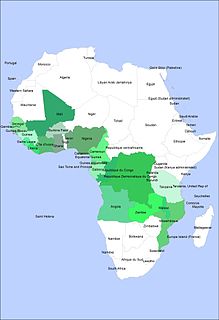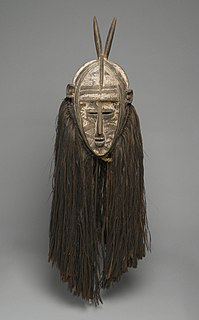Related Research Articles

A masquerade ball is an event in which many participants attend in costume wearing a mask. Less formal "costume parties" may be a descendant of this tradition. A masquerade ball usually encompasses music and dancing. These nighttime events are used for entertainment and celebrations.

A mask is an object normally worn on the face, typically for protection, disguise, performance, or entertainment. Masks have been used since antiquity for both ceremonial and practical purposes, as well as in the performing arts and for entertainment. They are usually worn on the face, although they may also be positioned for effect elsewhere on the wearer's body.

African art describes the modern and historical paintings, sculptures, installations, and other visual culture from native or indigenous Africans and the African continent. The definition may also include the art of the African diasporas, such as African American, Caribbean or art in South American societies inspired by African traditions. Despite this diversity, there are unifying artistic themes present, when considering the totality of the visual culture from the continent of Africa.

Egungun, in the broadest sense is any Yoruba masquerade or masked, costumed figure. More specifically, it is a Yoruba masquerade for ancestor reverence, or the ancestors themselves as a collective force. Eégún is the reduced form of the word egúngún and has the same meaning. [Rowlands, E.C. (1973-01-01). "Yoruba (Teach Yourself Books", chapter 7, page 39] There is a misconception that Egun or Eegun is the singular form, or that it represents the ancestors while egúngún is the masquerade or the plural form. This misconception is common in the Americas by Orisa devotees that do not speak Yorùbá language as a vernacular. "Egungun is a visible manifestation of the spirits of departed ancestors who periodically revisit the human community for remembrance, celebration, and blessings."

The Baule or Baoulé are an Akan people and one of the largest ethnicities in Côte d'Ivoire who historically migrated from what is today Ghana. The Baoulé are traditionally farmers who live in the centre of Côte d'Ivoire, in a triangle shaped region between the rivers Bandama and N'Zi. This area broadly encompasses the regions around the cities of Bouaké and Yamoussoukro. The Baoulé have come to play a relatively important role in the recent history of Côte d'Ivoire: the State's first President, Félix Houphouët-Boigny, was a Baoulé; additionally, since the Ivorian cocoa boom of the 1960-1970s, the Baoulé have also become one of the most widespread ethnicity throughout the country, especially in the Southern forests where they are amongst the most numerous planters of cocoa, rubber, and coffee and sometimes seem to outnumber the local native ethnic groups.
The diverse culture of Ivory Coast, a coastal West African country bordered by Ghana, Liberia, Mali, Burkina Faso, and Guinea, is exemplified by a multitude of ethnic groups, events, festivals, music, and art.

Topeng is a dramatic form of Indonesian dance in which one or more mask-wearing, ornately costumed performers interpret traditional narratives concerning fabled kings, heroes and myths, accompanied by gamelan or other traditional music instruments.
The Northern Edo Masquerades are a traditional ceremony practiced by the Edo people of Nigeria.
The Dan are a Mande ethnic group from northwestern Ivory Coast and neighboring Liberia. There are approximately 700,000 members of the group and their largest settlement is Man, Ivory Coast. Neighboring peoples include the Krahn, Kpelle and Mano. They are officially known as Yacouba in Ivory Coast. In Liberia, they are also known as Gio, which is considered a derogatory exonym.

The Kuba Kingdom, also known as the Kingdom of the Bakuba or Bushongo, is a traditional kingdom in Central Africa. The Kuba Kingdom flourished between the 17th and 19th centuries in the region bordered by the Sankuru, Lulua, and Kasai rivers in the heart of the modern-day Democratic Republic of the Congo.

Traditional African masks play an important role in certain traditional African rituals and ceremonies.

Igbo art is any piece of visual art originating from the Igbo people. The Igbo produce a wide variety of art including traditional figures, masks, artifacts and textiles, plus works in metals such as bronze. Artworks from the Igbo have been found from as early as 9th century with the bronze artifacts found at Igbo Ukwu. With processes of colonialism and the opening of Nigeria to Western influences, the vocabulary of fine art and art history came to interact with established traditions. Therefore, the term can also refer to contemporary works of art produced in response to global demands and interactions.
The Songye people, sometimes written Songe, are a Bantu ethnic group from the central Democratic Republic of the Congo. They inhabit a vast territory between the Sankuru and Lubilash rivers in the west and the Lualaba River in the east. Many Songye villages can be found in present-day East Kasai province, parts of Katanga and Kivu Province. The people of Songye are divided into thirty-four conglomerate societies; each society is led by a single chief with a Judiciary Council of elders and nobles (bilolo). Smaller kingdoms east of the Lomami River refer to themselves as Songye, other kingdoms in the west, refer to themselves as Kalebwe, Eki, Ilande, Bala, Chofwe, Sanga and Tempa. As a society, the people of Songye are mainly known as a farming community; they do, however, take part in hunting and trading with other neighboring communities.
The Chamba people are a significant ethnic group in the north eastern Nigeria. The Chamba are located between present day Nigeria and Cameroon. The closest Chamba neighbours are the Mumuye, the Jukun and Kutep people. In Cameroon, the successors of Leko and chamba speakers are divided into several states: Bali Nyonga, Bali Kumbat, Bali-Gham, Bali-Gangsin, and Bali-Gashu. The are two ethnic groups in Ghana and Togo also called Chamba, but they are ethnically distinct. The Chamba are identified through their own language, beliefs, culture, and art.

Nyau is a secret society of the Chewa, an ethnic group of the Bantu peoples from Central and Southern Africa. The Nyau society consists of initiated members of the Chewa and Nyanja people, forming the cosmology or indigenous religion of the people. Initiations are separate for men and for women, with different knowledge learned and with different ritual roles in the society according to gender and seniority. Only initiates are considered to be mature and members of the Nyau.

Kuba art comprises a diverse array of media, much of which was created for the courts of chiefs and kings of the Kuba Kingdom. Such work often featured decorations, incorporating cowrie shells and animal skins as symbols of wealth, prestige and power. Masks are also important to the Kuba. They are used both in the rituals of the court and in the initiation of boys into adulthood, as well as at funerals. The Kuba produce embroidered raffia textiles which in the past was made for adornment, woven currency, or as tributary goods for funerals and other seminal occasions. The wealth and power of the court system allowed the Kuba to develop a class of professional artisans who worked primarily for the courts but also produced objects of high quality for other individuals of high status.
Kuba Divination is a form of divination used by the Kuba people of central Africa.

The Bushong Kuba are responsible for some of the most beautiful and sophisticated masquerade or dance traditions in Africa.

Masks are the most important art form of the Dan people of Liberia. The Dan people refer to these masks as gle or ge, terms that refers both to the physical mask and the individual spirits the mask is believed to embody during masquerade performances.

Burkina Faso is a small, landlocked country north of Ghana and south of Mali and Niger. Economically, it is one of the four or five poorest countries in the world. Culturally, it is extremely rich. In part this is because so few people from Burkina have become Muslim or Christian. Many of the ancient artistic traditions for which Africa is so well known have been preserved in Burkina Faso because so many people continue to honor the ancestral spirits, and the spirits of nature. In great part they honor the spirits through the use of masks and carved figures. Many of the countries to the north of Burkina Faso had become predominantly Muslim, while many of the countries to the south of Burkina Faso are heavily Christian. In contrast many of the people of Burkina Faso continue to offer prayers and sacrifices to the spirits of nature and to the spirits of their ancestors. The result is that they continue to use the sorts of art that we see in museums in Europe and America.
References
- 1 2 Mack, John. "Animal Representations in Kuba Art: An Anthropological Interpretation of Sculpture" in Oxford Art Journal, Vol. 4, No. 2, Sculpture (Nov., 1981), pp. 50-56. Published by: Oxford University PressArticle Stable URL: https://www.jstor.org/stable/1360140
- ↑ Binkley, David A; Patricia Darish (2009). Kuba. Milan: 5 Continents Edition.